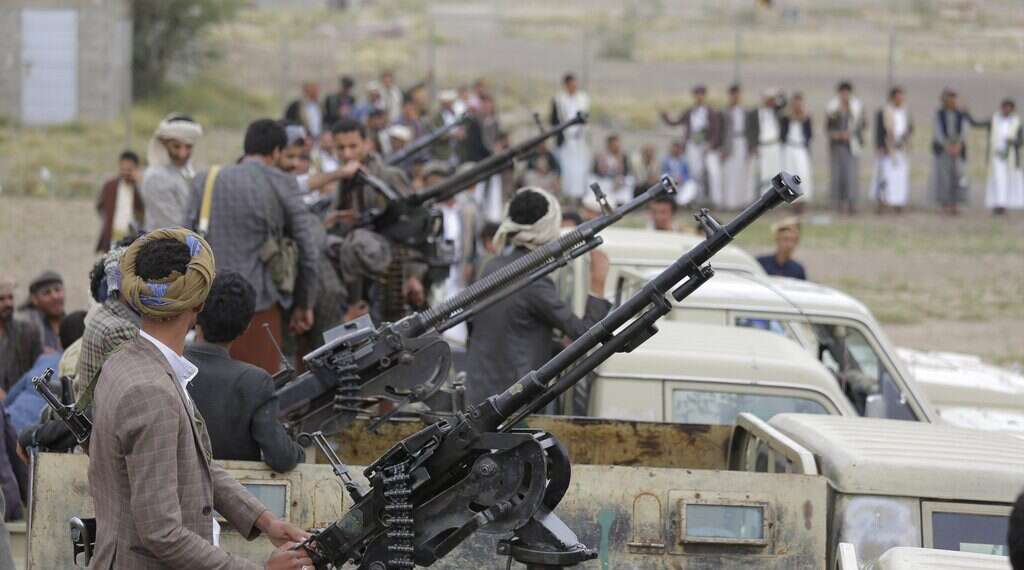by Neville Teller
New developments have complicated the conflict on the Arabian Peninsula's southern flank. What compromise can there be between the Saudi-backed president of a united Yemen and the UAE-backed southern separatists and Iranian-supported Houthis?
 |
| In this Aug. 1, 2019 file photo, Houthi rebel fighters ride on trucks mounted with weapons, during a gathering aimed at mobilizing more fighters for the Houthi movement, in Sanaa, Yemen. Airstrikes by the Saudi-led coalition fighting Yemen’s rebels Houthi hit a detention center in southwestern province of Dhamar, officials and the rebels’ health ministry said Sunday | Photo: AP/Hani Mohammed, File |
Distressing as recent events have been in Yemen, a country torn apart by civil war that has led to a humanitarian disaster on a massive scale, the main outline of the conflict and the reasons behind it seemed, until quite recently, reasonably comprehensible. Now new developments have thoroughly complicated the issues.
This Yemen conflict started in the sadly misnamed “Arab spring” uprisings of 2011. Mass protests, a near-assassination of then-President Ali Abdullah Saleh, and pressure from neighboring petro-states forced Saleh to step down in favor of his vice president, Abed Rabbo Mansour Hadi. The political instability was largely caused by attempts of the Iran-backed Houthi rebels to overthrow Saleh’s government.
These events in North Yemen were echoed by a constitutional upheaval in the south. In 1967 South Yemen was established as a socialist state under the protection of the USSR. Relations between the two Yemens deteriorated, and in 1972 they took up arms against each other. A ceasefire, brokered by the Arab League, included the aspiration of unification in due course. It took a further 18 years of military and political infighting before that aspiration was realized, but in 1990 the unified Republic of Yemen came into being. Ali Abdallah Saleh, who had been president of North Yemen since 1978, was proclaimed president of the newly united state.
Saleh had given up the keys of office with a very bad grace, and was quite prepared to ally himself with his erstwhile enemies, the Houthis, in an attempt to maneuver his way back to power. The subsequent turn of events seems depressingly familiar in the context of Yemen’s long history. Saudi Arabia, determined to prevent Iran from extending its footprint into the Arabian peninsula, intervened in March 2015 to beat back the Houthis. Saudi Crown Prince Mohammed bin Salman assembled a coalition of Arab states, obtained the diplomatic backing of the US, UK, Turkey, and Pakistan, and launched a series of airstrikes against the rebels.
The unconventional Saleh-Houthi partnership came to an abrupt end on December 2, 2017, when Saleh went on television to declare that he was splitting from the Houthis and ready to enter into dialogue with the Saudi-led coalition. This volte-face was to end in tragedy. On December 4, Saleh's house in Sanaa was besieged by Houthi fighters. Attempting to escape, he was killed.
Now the glue binding the two Yemens has come unstuck.
The first signs appeared as far back as 2007, when a south Yemen separatist movement was formed with the aim of re-establishing South Yemen as a sovereign state. Ten years later, in 2017, the movement set up the Southern Transitional Council, backed by the United Arab Emirates.
Separatists from the STC are part of the military coalition fighting the Houthi rebels; so is the UAE. But suddenly, in the first week of August 2011, separatist forces seized government military bases and began an assault on Aden. Thousands of people poured into the streets to support them, waving the old South Yemen flag.
It was a delicate situation. The UAE and Saudi Arabia had been firm allies in attempting to crush the Houthis but they now found themselves on opposite sides of this separatist uprising. Fortunately, cooler counsels prevailed. Saudi-UAE discussions led to a ceasefire. By August 16, southern separatists had vacated key public buildings in Aden, and the STC had welcomed Saudi Arabia’s call for dialogue.
But this episode introduces a new factor into an already complex situation. It is more than a minor spat between allies. In the long run, what sort of compromise can there be between the Saudi-backed president of a united Yemen fighting to maintain the integrity of his state, and the UAE-backed STC, dedicated to re-establishing an independent nation of South Yemen? Suddenly Yemen’s President Hadi is facing two enemies: the Houthis and the southern separatists.
Words issued on August 14 from UN envoy Martin Griffiths, currently watching events from the sidelines, sound true but ineffectual: “The conflict in Yemen can only be resolved through an inclusive political process.”
Indeed, but how long must Yemen’s agony persist?
Neville Teller
Source: https://www.israelhayom.com/2019/09/02/the-disintegration-of-yemen/
Follow Middle East and Terrorism on Twitter
No comments:
Post a Comment